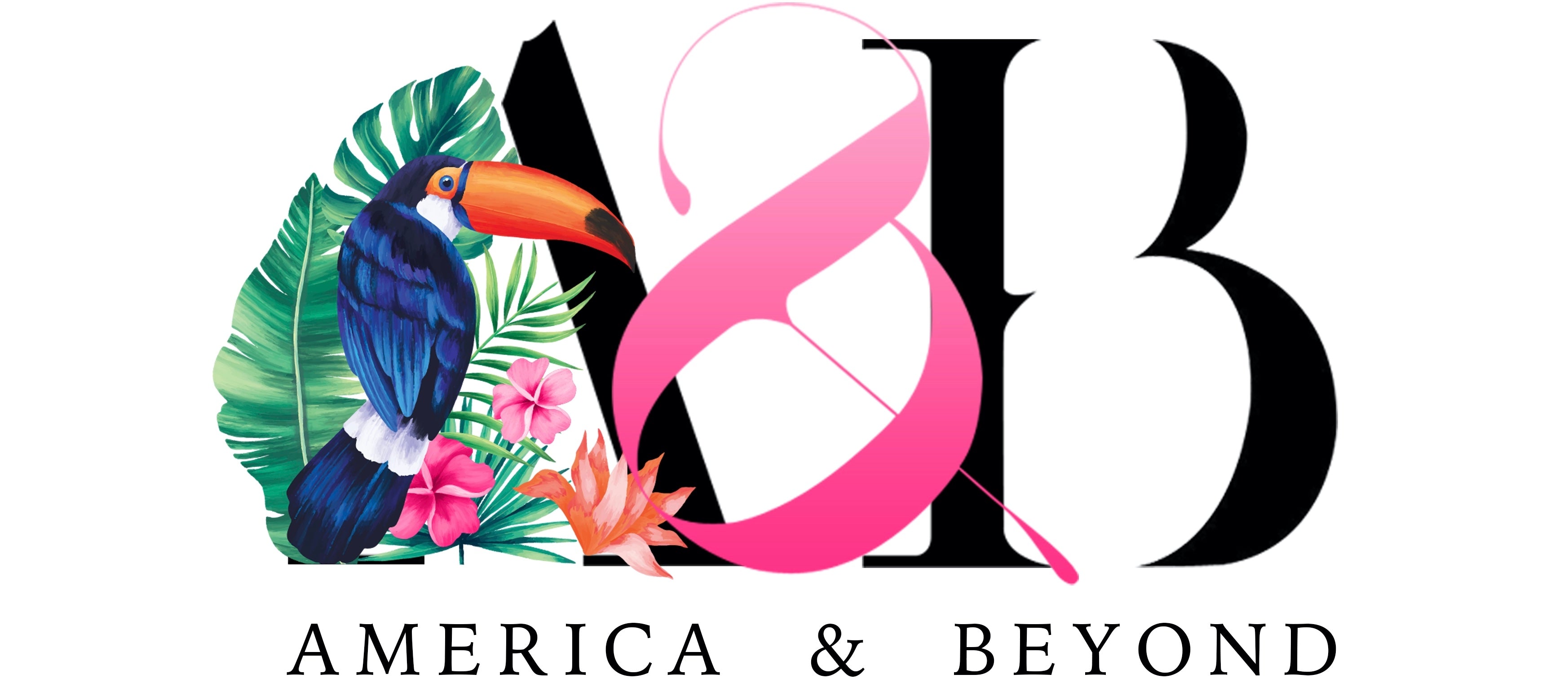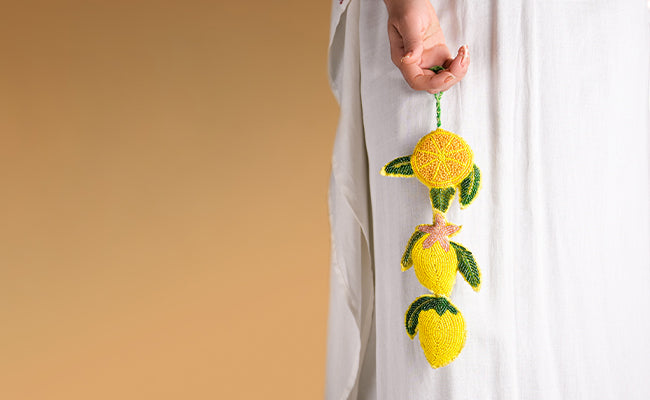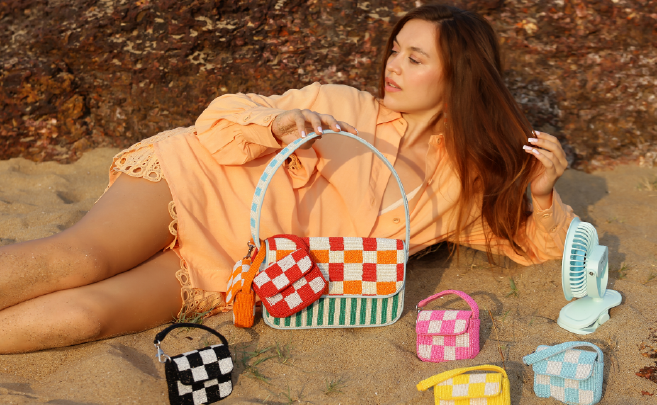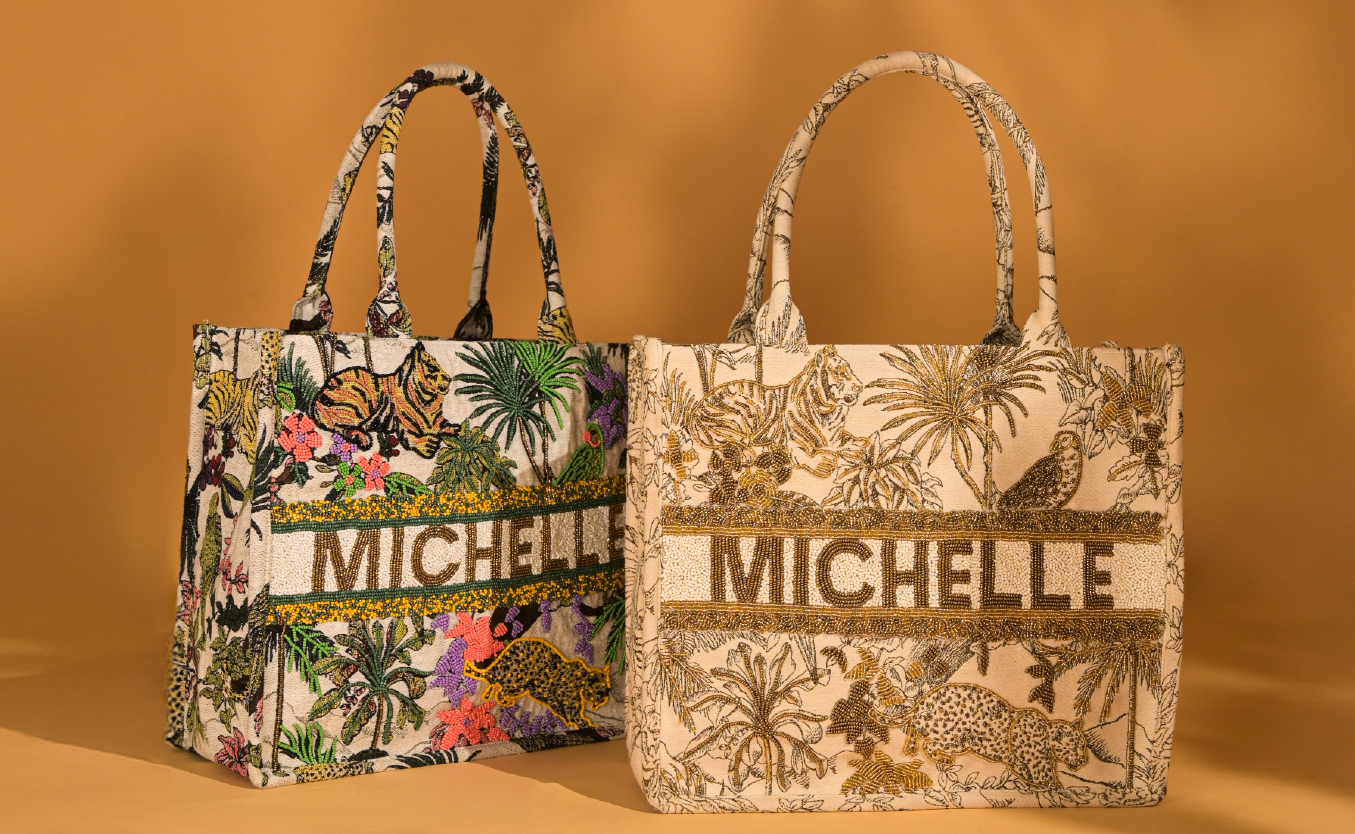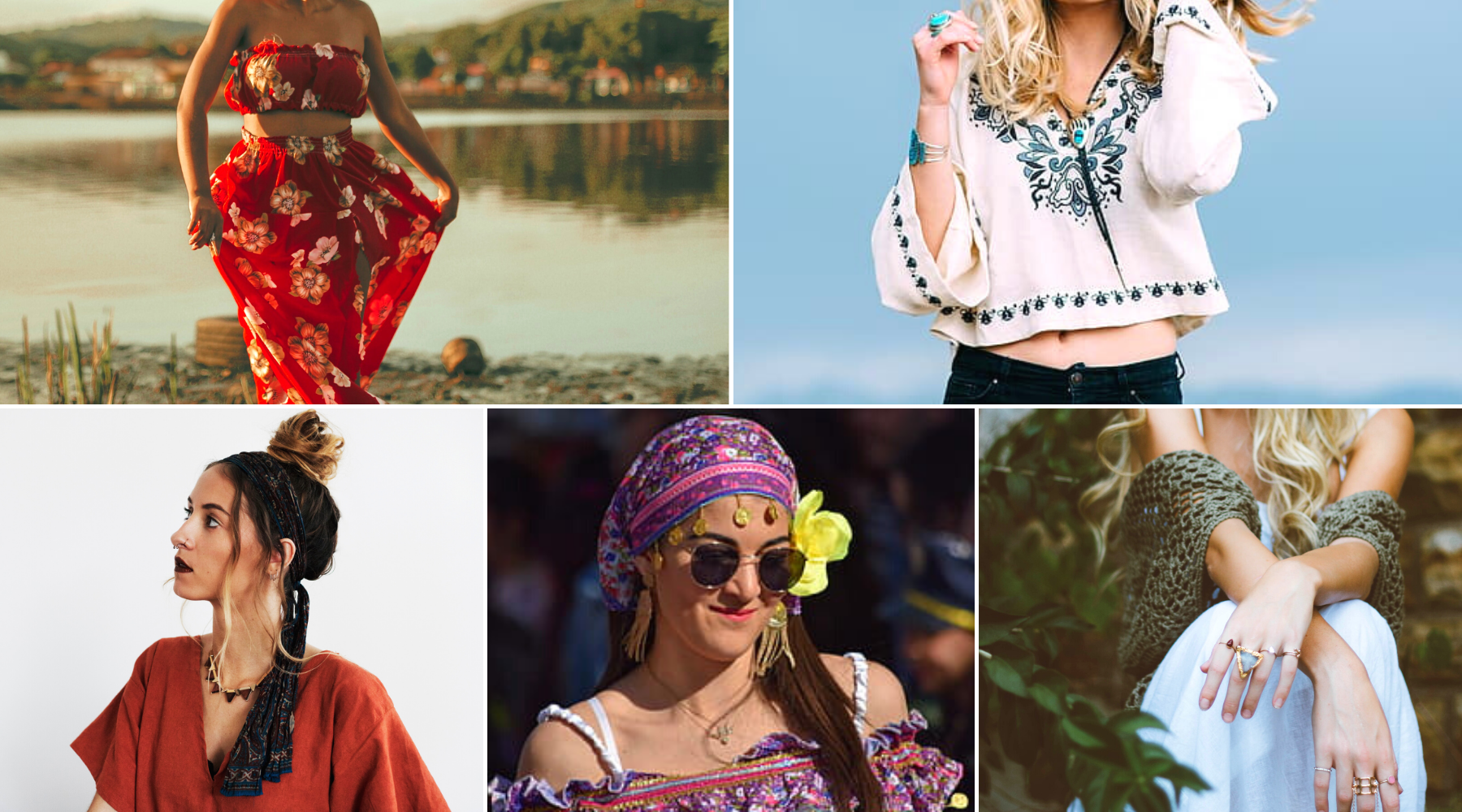
The Colorful History of Bohemian Style & How To Dress Boho-Chic
When you hear the word ‘Bohemian’, what comes to mind? You may imagine a creative artist with a unique, colorful, and ‘hippie’ style. You’ll be right, but there’s much more to the boho story! What’s now a wildly popular fashion movement began as a fascinating culture over 200 years ago with roots in the artistic streets of 18th century Paris.
In this blog, you’ll find out all about bohemianism, its rich history, and the ultimate style guide on how to authentically dress ‘boho-chic’.

Photo by Caroline Hernandez on Unsplash
1. What Does it Mean To Be Bohemian?
At the heart of it all, being boho has always been about being free - in mind, body, and spirit. Bohemianism started out as a counterculture by French artists, writers, and creatives that encouraged creativity, artistic expression and rejected the accepted fashions and suffocating social rules of the 18th century.
Forced to live in poverty after the French Revolution ended, these artists began living a simpler, more nomadic lifestyle that focussed less on possessions and more on creative freedom. This slowly evolved into the bohemian mindset, which meant expressing themselves in how they dress and what they create.
2. Where Does Bohemian Style Come From? A Timeline

Photo by Minh Pham on Unsplash
Boho culture has a fascinating and rich history that traveled from the mysterious streets of France to England, and to the USA, before becoming a global phenomenon. Let’s retrace the steps of this colorful culture back to its very roots.
The Origin of Bohemian Culture
The word ‘Bohemian’ began to appear first towards the end of the 18th Century. With the end of The French Revolution, creative artists like painters, musicians, and writers who earlier enjoyed the patronage of wealthy French royalty and aristocrats, were now forced into poverty. Deprived of a means to an income, they had to live on very limited means.
These conditions slowly led the artistes to embrace a life that was minimalistic and nomadic in nature. They began focusing less on material possessions and more on expressing their creativity through this newfound lifestyle, often repurposing old and used clothing into artistic and quirky outfits.

The early bohemian clothing style resembled that of nomadic tribes. Photo courtesy Flickr
Why were they called ‘Bohemian’?
Since this new group of creatives dressed in artistic and quirky ways, the general public initially compared them to the nomadic gypsies who dressed similarly and had migrated from an area of Eastern Europe called ‘Bohemia’. While French society used the word ‘Bohemian’ in a derogatory way towards the Nomadic Romani populations, the term slowly began to be used to describe a creative or an intellectual with a highly artistic and eccentric dressing sense and lifestyle.
A Pre-Raphaelite Painting with early boho elements like flowing hair, embroidered dress, and lace. By John Everett Millais - http://images.onlinegalleries.com/gfx/13488.jpg
Early 19th Century: Romantic Era and French Bohemians
Early 19th Century saw the rise of the Romantic Era in Europe which broke free from the formal shackles of classicism and emphasized the importance of emotions and aesthetics in music, art, and literature. The Romantics joined the French Bohemians and began incorporating vibrant, free-flowing robes, hair accessories, and weathered fabrics into their dressing style.
Mid 19th Century: London’s Pre-Raphaelite Movement
Strikingly similar to The Romantics in France, Britain saw the rise of Pre-Raphaelites. This group of British artists wanted to infuse creativity, sincerity, and emotion in art and literature. The Pre-Raphaelites rejected restrictive clothes like corsets and stiff clothing in favor of unrestricted dresses, flowing hairstyles with flowers for adornment, and colorful beaded necklaces. This further popularized the free-spirited bohemian aesthetic.
Late 19th Century: The Aesthetic Movement
As the 19th Century neared the end, so did Europe’s patience for restrictive ways of dressing and creative expression. The Aesthetic movement focussed on free expression, and incorporated natural elements like florals, animal-inspired prints, and oriental patterns and motifs into art and fashion.
1950’s Beatnik Culture In The USA
Cut to 1950’s America, and you’ll see the rise of Beatniks. This group of people were fierce supporters of free speech and were non-conformists. They often wore simple, low-profile clothes that were often all-black, but they expressed their individuality through their art, poetry, and literary work. Their beliefs sowed the seeds of The Hippie Culture in the 1960s.

The free-thinking, minimalist Beatnik style. Source: Erika Zabowski on Flickr
Post-1960’s: Beatnik + Boho = Hippie Culture
The Hippie Culture of 1960’s America combined the non-conformist Beatnik philosophy with the colorful, free-spirited Bohemian aesthetic to give birth to the Boho fashion style that we see today. Hippies expressed their individuality with colorful fabrics and wore soft, flowing dresses, scarves, and kimonos. They also wore handcrafted accessories, boots, and jewelry with tassels, fringes, and beaded embellishments. Floral prints, animal patterns, and quirky color combinations became quite popular as well.

Tie-dye shirts, chunky jewelry, and round glasses were signature hippie elements. Image by tbstyleworks0 from Pixabay
The early 2000s to present
The 2000s blended various elements of different boho styles into the ‘boho-chic’’ aesthetic that’s popular all over the world today. It takes inspiration from the hippie and bohemian clothing styles and adapts it to modern sensibilities. More on that below!
3. What is Boho-Chic Style?

Boho-chic: A blend of boho, flowy, and contemporary elements. Image by Capucine Moda from Pixabay
Boho-chic style is the newest avatar of the bohemian aesthetic that’s being loved across the world. To put it simply, boho-chic takes the vibrant, flowy, and retro elements of the hippie and bohemian fashion and adapts it to a more contemporary look. This way, it retains the wonderfully messy, relaxed, and colorful boho vibe while mixing it with the slightly more urban elements of today.
4. What Does Boho Style Mean: Aesthetic Elements

Embroidery, tie-dye, and crochet are signature bohemian elements
Boho style, or ‘boho-chic’ fashion, has evolved in interesting ways over the course of its 200-year old history. However, even so, quintessential boho fashion has several aesthetic elements that define this unique sense of style:
Colors: Earthy, rich colors like greens, deep yellows, maroons, neutrals like browns, beige, and pastels form a big part of the boho color palette. Sister shades, or different shades of the same color, are often mixed together in a boho outfit, rather than wearing a single color across the outfit. Overly saturated, neon or fluorescent colors go against the earthy, natural boho look and are usually avoided.
Silhouette: The boho style is all about feeling at ease in your own skin. This means loose, flowing silhouettes that are comfortable and breezy translate into flowing dresses, skirts, lounge pants, and wide-sleeved tops.
Materials: Comfort is key when it comes to bohemian fashion. This is why you’ll find most boho pieces made with soft, comfortable, and often natural materials. Fabrics like cotton, denim, chiffon, leather, and suede work really well.
Dazzling Embellishments: Little, artful details go a long way in expressing your unique style. Intricate embellishments such as hand-embroidery, beadwork, tassels, pom-poms, studs, and applique work can be widely found on boho outfits.
Patterns: Boho clothes can be easily identified with their eye-catching, vibrant, and bold patterns such as paisley prints, florals, tribal patterns, and tie-dye patterns.
Techniques: Boho fashion often uses handmade techniques to create their clothes, as it places importance on individual creativity. Methods like macrame (a knotting technique), patchwork for clothes and bags, and delicate lacework give boho pieces their unique, eccentric individuality.

Handmade Macrame is an essential boho-chic technique. Image by benjamin francois from Pixabay
5. Legendary Boho Icons Over The Years

Janis Joplin embodied the colors, style, and free-spirit of the hippie culture
While countless people across different eras and countries contributed to the evolution of the bohemian style, a few towering figures shaped the boho aesthetic in important ways, and have blazed an unforgettable trail with their signature sense of style.
1920’s - Dorelia (Dorothy) McNeil: As a model to artists Augustus John and Gwen John, Dorothy McNeil brought the enigmatic bohemian lifestyle and its free-spirited fashion aesthetic to life for the first time, by donning colorful scarves, and long, flowing dresses when posing for their paintings.
1950’s - Juliette Greco: The French actress and singer became a huge boho influence and introduced the ‘Beatnik’ boho style with her affinity for oversize, baggy clothes, wearing all-black and golden footwear.
1960’s - Talitha Getty: Actress, socialite, and the grand-daughter of Dorelia Mcneil, Talitha Getty was a flamboyant style icon whose pioneering boho-chic sensibility still influences designers today. With her broad-brimmed hats, harem pants, colorful caftans, knee-length boots, or colorful maxi dresses, she was a true embodiment of the fearlessly creative ‘hippie’ boho aesthetic.
1970’s - Janis Joplin: Aside from being a fiercely talented and mammoth figure in the Rock ‘n Roll music scene, Janis Joplin also popularized the boho-chic fashion style with her signature oversized round sunglasses, colorful bracelets, long beaded necklaces, and stylish headwear.
6. How Do You Look Boho-Chic? The Essential Lookbook

If you’re looking to dress in true boho-chic style, we’ve got you covered. By choosing a few quintessentially boho pieces and accessories, you’ll be able to mix and match to come up with a style that is not just boho, but truly unique to you. Here are some tips to keep in mind when putting together your boho-chic ensemble:
Boho Tops

Boho beach-ready lace top & floral, breezy daffodil blouse
When picking tops to add to your boho closet, go for relaxed, gentle silhouettes like off-shoulder tops and spaghetti straps, instead of tight, form-fitting silhouettes. Here are some tips to keep in mind:
- Choose off-shoulder tops, V necks, or spaghetti straps to amp up the relaxed aura.
- Vibrant patterns like florals, ethnic, or animal prints (leopard and tiger prints).
- Intricate embroidery, beadwork or embellishment along the neck or sleeves add an eclectic, handmade touch
- Wide, flared or ruffled sleeves
The Bottoms

Breezy pieces like maxi skirts, lounge pants, and cotton shorts are absolute bohemian essentials. While their waists are cinched, the rest of the garment usually has a relaxed, wide cut. Go for pieces with neutral, earthy base colors, and don’t be afraid to go big on vibrant patterns and layered ruffles - they’ll make you feel like the true boho queen that you are:
- Pick long, flowing maxi skirts, lounge boho pants with wide-leg cuts, and cotton shorts
- Go for rich patterns like florals, tie-dye, jungle print, leopard prints
- Layered skirts with ruffles and frills add a playful element
- Look for delicate embroidery along the waist and hem
- Fabrics like crochet, weathered denim, cotton, linen work well
Boho Style Dresses

The boho-chic rainbow stars off-shoulder dress & waterfall maxi dress
Maxi dresses or knee-length A-line dresses with easy-fitting, gentle cuts are a staple in the boho-chic wardrobe. Try dresses in solids with rich embroidery and embellishments, or go for vibrant prints.
- Long, flowy boho maxi dresses, A-line knee-length dress, wrap dresses
- Off-shoulder and deep V-necks with embroidery along the neck
- Solid colors with rich embroidered details
- Vibrant prints like paisley, florals, ethnic prints
- Wide, flared sleeves in half or three-quarters length
Kimonos

Our twilight jungle kimono & boho crochet festival kimono
Throwing an airy, loose kimono over your outfit is a lovely way to layer your boho look all through the year. You can pair them with strappy tops and maxi skirts, as a cover-up over your swimwear at the beach, or even over your winter cardigan for a pop of color in the freezing cold.
- Choose full-length or short kimonos with wide, flared or ruffled sleeves
- Blend patterns like paisley, florals, and abstract patterns
- Go for sheer fabrics that are soft to the touch, crochet works well too
Accessories

Accessorizing is a massive part of the bohemian look - it’s the perfect way to mix and match elements to come up with a style that’s entirely your own. And don’t be afraid to go bold - oversized rings and earrings, multi-colored handbags - the bigger, the better!
- Bags
- Crossbody bags, drawstring bags, and tote bags
- Choose jute, macrame, leather, or cotton for a natural look.
- Look for bags with embroidery, tassels, fringes, and pom pom detailing
- Jewelry and hats
- Go for chunky, oversized rings, pendants, bracelets and big earrings
- Pearl, gemstones like turquoise, wood beads and antique silver
- Freely experiment with complex designs and mixing differently-sized stones
- Choose metals with antiquated, oxidized finishes for a rustic charm
- Wear multiple stackable bracelets and rings over each other
- Look for beaded necklaces, bracelets and anklets
- Wear broad-brimmed hats, fedoras, straw hats and floppy hats with embroidery
Footwear

Don’t forget to pair your boho outfit with the right footwear! For summer, boho sandals, flats, and gladiators work great, while the ankle and knee-length boots are perfect for the winter. Go for intricate, colorful beadwork and embellishments on the sandals to perfectly complement your outfit.
- Gladiators, T-strap flat boho sandals, open-toed sandals, heeled sandals
- Go for tribal and ethnic designs with colorful, intricate beadwork, mirror work, and fringes
- For boots, go for ankle and knee-length styles in neutral tones like browns and beige
Boho Hairstyles

When it comes to your hair, it’s a great idea to go for more relaxed and comfortable styles that don't require too many pins and ties to stay in place.
- Gentle beach waves and messy buns are low-maintenance and add a lovely free-spirited charm to your look
- Braids in different styles like the three-way, fishtail, and french braids go beautifully with boho dresses, lounge pants, and kimonos. Try keeping the hair somewhat loosely braided to avoid an overtly-neat look
7. Do’s and Don’t Of Boho-Chic Fashion

Image by Ben Frieden from Pixabay
While the bohemian spirit is all about expressing your individuality, here are some styling tips you can follow to nail that wonderfully carefree boho-chic look:
Choose Comfort: When it comes to going boho, comfort comes first. Look for clothes that are flowy and soft with gentle silhouettes. To add an urban touch, you can pair loose silhouettes with slightly more fitted pieces - try pairing wide legged lounge pants with a fitted strappy top and a wide-sleeved shrug.
Natural Fabrics: Natural materials like cotton, denim, leather, suede, linen, rayon, and silk work wonderfully with boho pieces, and are in line with its earth-friendly philosophy.
Avoid Neons, Over-Saturated Colors: Any shades that look too saturated, like fluorescent green, royal blue, and neon pink should be avoided. Instead, go for earthy colors, neutrals or pastels and try pairing different shades of the same color with each other. Try going for a lavender top with a mauve kimono and beige linen lounge pants.
Mix Small Prints With Bigger Patterns: Mixing different prints adds an interesting texture to your look. However, to not overwhelm yourself with patterns, mixing smaller prints like dots and small floral patterns with bigger prints like paisley or jungle patterns is a good idea.
Details Are Everything: Beautiful, intricate detailing on your clothes will bring out your individuality and set you apart from followers of mass-produced clothes. Choose clothes with details like hand-embroidered motifs, studs, tassels, fringes, beaded patterns, embellishments, lace, and mirror work.
Choose Artisanal Items: When you’re shopping, keep an eye out for artisanal clothes and accessories with a unique design or look. Artisan-crafted jewelry, footwear, and clothing pieces have a beautiful, human touch to their designs that machine-made, assembly line clothes just can’t compete with when it comes to individuality.
Accessorize, Accessorize, Accessorize: Believe us when we say that clothes only form a small part of the boho look - it’s actually the accessories that make all the difference! So accessorize to your heart’s content - whether it’s earrings, bracelets, necklaces, anklets, embroidered tote bags, or bejeweled boho sandals - or try them all!
Layer Your Look: Layering different clothes and accessories work wonders in adding depth and uniqueness to your look. Feel free to throw on a colorful kimono over your top and lounge pants, or wear multiple stackable bracelets and rings.
Avoid Minimalism, Go Big: The bohemians are free spirits that don’t shy away from being themselves, and this remains true with their clothing and accessories. Go big with chunky pendants, oversized rings, and large hoops and stone earrings.
Don’t Be Afraid to Get Messy: The neater and more minimal a piece is, the less boho it is. So, look for clothes and accessories in vibrant colors, various patterns, and unique details and elements. After all, the early bohemians pioneered this quirky, eccentric style by putting together many different aesthetic elements without fear.
Final Thoughts

Photo by Nicole Geri on Unsplash
A counterculture that began in the 1800s by impoverished, non-conformist, and passionate artists is now being celebrated the world over for its unique and mesmerizing style. But the boho philosophy goes well beyond its fashion aesthetic - it’s about freely expressing yourself in artistic ways, and embracing your unique individuality.
The bohemian style, with vibrant prints, flowing silhouettes, and artful details is a meeting point of cultures from across the world. It beautifully reflects how our beliefs and ideas can impact how we create, express ourselves, and dress. The boho philosophy is here to stay and will continue to evolve in unique, refreshing ways that seamlessly flow with the times.
